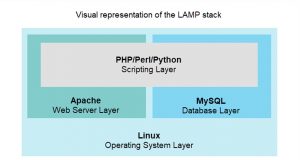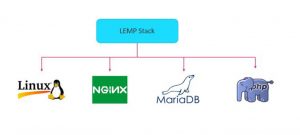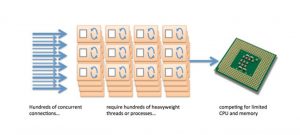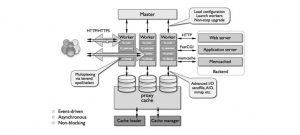What is a LAMP stack?
Some of today’s most popular open-source web applications – for example, WordPress and Drupal – run on the LAMP stack. That wouldn’t be surprising, since some have heard about the LAMP stack.
LAMP has a lot to offer in addition to being one of the first open-source web stacks. It is one of the most common ways to deliver web applications, and it remains so. Because it is so widely used, you are likely to come across it frequently as you update or host existing applications. Many people consider it to be the preferred platform for developing new custom web applications.

Components of LAMP for Web development
A LAMP stack is an open-source collection of software used to build websites and web applications. It consists of Linux operating systems, Apache web servers, MySQL databases, and PHP programming languages. Each component plays an essential role in the stack:
- Linux: It is an operating system used to run the rest of the components.
- Apache: The HTTP Server is a web server software used to serve static web pages.
- MySQL: It is a relational database management system used for creating and managing web databases, but also for data warehousing, application logging, e-commerce, etc.
- PHP: This is the programming language used to create web applications.

LAMP architecture
The LAMP stack has traditional three-layer architecture, with Linux serving as the foundation. Apache and MySQL are at the next level, and PHP is at the highest level. Although PHP is conceptually in the uppermost layer, the PHP component is embedded in Apache.
What is LEMP Stack?
LEMP is a bundle of server applications with Linux OS, eNgine-X(Nginx) Web server, MySQL / MariaDB Database, PHP/Perl Language.
Since Nginx handles enormous traffic, LEMP is the preferred choice for hosting companies. MariaDB is used for databases and PHP for loading dynamic web pages.
Because all the components are open-source, you may get started with the LEMP stack for FREE.

Choosing LEMP over LAMP is primarily a decision between Nginx and Apache as web servers. Both solutions are widely used and excellent, so picking among them is mostly a matter of personal preference. In terms of usability, LAMP and LEMP are equally efficient, but we can compare them based on our needs.
Basic architecture
The fundamental difference lies between Apache and Nginx design architecture. They differ in the way they handle connections and traffic and respond to different traffic conditions.
The basic architecture of Apache can lead to heavy resource consumption. It can cause issues with the server for example – slow speed.

Nginx employs an event-driven architecture. Nginx can be used on low-power systems and systems that operate under heavy loads.

Performance & Speed
Nginx is great at delivering static content rapidly and efficiently. However, if you want to host numerous websites on a single server, Apache is the better choice.
For Static content
- Apache serves static content using the file-based method.
- Nginx serves much faster when it comes to static content.

For Dynamic Content
- Apache process dynamic content within the server.
- Nginx doesn’t process dynamic content.

Request Interpretation
The Apache and Nginx get processed and interpret requests differently. The different methods of interpreting requests to make them unique and better than others.
1. Apache passes file system location
As a physical resource on the file system location that may need more abstract evaluation. It provides the ability to interpret requirements.

2. Nginx passes URI to interpret requests
Nginx was created to be a web server and a reverse proxy. Nginx works primarily with your eyes and it translates to the system when necessary.

User-friendly – Apache is more convenient and less technical when it comes to setup & configuration. Apache is like Windows while Nginx is more like Linux. It means that Nginx is better for technical guys and Apache is good for home users.
Market & Community Share – Although Apache was introduced earlier than Nginx, it has a greater market share and community of developers. But the incredible performance of Nginx has attracted most developers.
Features of Nginx and Apache
- Nginx uses low memory consumption technology.
- CPU and memory usage does not get affected because Nginx is single-threaded.
- Apache works better for dynamic websites while Nginx is best for static websites.
Evolution of LAMP to LEMP
Over a period, people found that LAMP was not very scalable, especially when it came to data storage. In such a scenario, people started to look for a scalable solution that could maintain the same functionality as LAMP as well as provide scalability. Enter, the concept of an Extended LAMP Stack. With the help of the LEMP stack, you’ll be able to handle more requests, store more data and deliver a better overall experience to the user. An Extended LAMP Stack is more than just adding more components to the existing stack as it’s a complete transformation from the existing stack. While people were using the term ‘LAMP’, they were using ‘Linux, Apache, MySQL, Php’. But, as the popularity and usage of LAMP grew, people started to use the term LAMP to refer to the above-mentioned components.
Conclusion
Both Apache and Nginx are strong, adaptable and competent. The evaluation of your unique requirements and testing with the patterns you anticipate seeing are key factors in determining which service is appropriate for you.
These differences in projects affect the capabilities, implementation time, and raw performance required to utilize solutions in production in very serious ways. Use the approach that best satisfies your goals.






Add comment